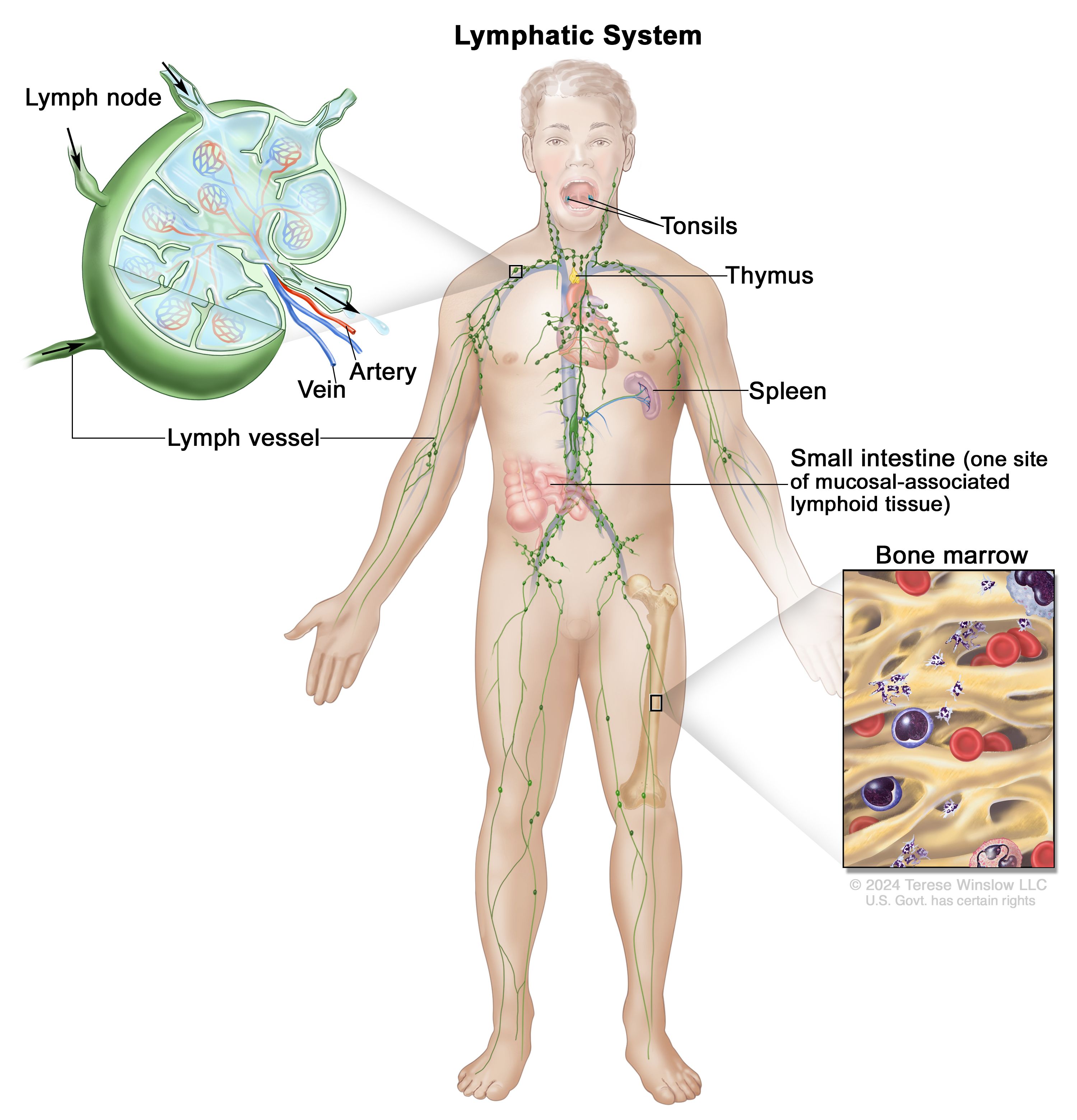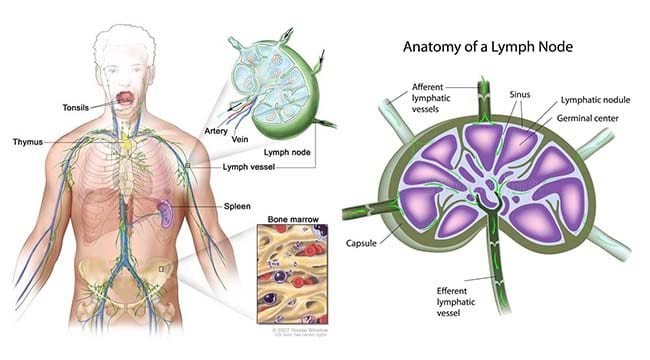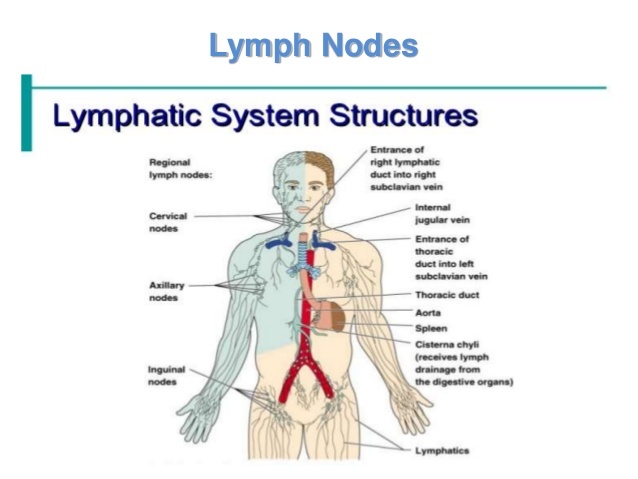Describe the Structure and Function of Lymph Nodes
In this article we will discuss the location and function of this immune system organ. The spleen tonsils adenoids and thymus all form a part of the lymphatic system.

Definition Of Lymph Node Nci Dictionary Of Cancer Terms National Cancer Institute
The lymphatic system is a circulatory system for lymphatic fluid comprising a network of conduits called lymphatic vessels that carry the fluid in one direction toward the heart.

. In the cut section the lymph node consists of an outer dense cortex and an inner pale medulla. The lymph nodes are small bean shaped glands or bulbs that tend to occur in clusters much like grapes. Lymph nodes are small bean-shaped organs of the lymphatic system.
It is a collection of lymphoid tissue enclosed in a connective tissue capsule and lying along the lymphatic stream. The lymph nodes. What are the functions of the structure seen here.
Also learn about its functions. Lymph nodes are situated deep within tissues and also in superficial clusters that drain specific. The lymphatic system plays a key role in the immune system fluid balance and absorption of fats and fat-soluble nutrients.
Lymphocyte proliferation immune surveillance and response and filtration of blood Gathering and removal of pathogens entering the pharynx in food or in inhaled air. Lymph node is small oval or bean-shaped body. Lymph contains cell wastes like cancer cells bacteria and viruses.
The lymphatic system consists of numerous lymph nodes deep inside the body. A colorless watery bodily fluid carried by the lymphatic system consisting mainly of white blood cells. Oval shaped organ of the lymphatic system- distributed widely throughout the body.
Lymph nodes serve two major functions in the body. Its functions include providing sites for certain immune system functions and facilitating plasma circulation in the cardiovascular system. It is a circulatory system for lymph fluid and the site of many key immune system functions.
From the capsule strands of tissue pass into the substance of the node and. Lymph is subsequently filtered by lymph nodes and directed into the venous system. The lymphatic system functions to drain tissue fluid plasma proteins and other cellular debris back into the blood stream and is also involved in immune defence.
Filter out the bad stuff- remove and destroy microorganisms and remove debris from the lymph so all the bad is filtered out before returning to the bloodstream. Lymphatic system is considered as a part of both the circulatory and immune systems as well as a usually neglected part of students books. The lymph gets filtered at the lymph nodes.
In this article we will discuss about the structure of lymph node with the help of suitable diagrams. Lymph nodes are traditionally regarded as having three compartments the cortex paracortex and medulla. The primary function of the lymphatic system is to transport lymph a fluid containing infection-fighting white blood cells throughout the body according to the journal Lymphatic Research Biology.
Surrounded by a fibrous capsule outer-cortex. Normal structure function and histology of lymph nodes. Lymph nodes are located at intervals along the lymphatic system.
Lymphatic system anterior view The lymphatic system is a system of specialized vessels and organs whose main function is to return the lymph from the tissues back into the bloodstream. On the opposing side there is a concavity that is penetrated by the supplying artery vein and nerve and also allows exit of efferent lymphatic vessels. Lymphoid tissue contains lymphocytes and other specialized cells and tissues that have immune system functions.
Definition and Function of Lymph Nodes in the Body. 05 marks for each blank Lymph nodes are _____ lymphatic organs lying along lymphatic vessels and. The functions of the lymphatic.
These are kidney-shaped bodies which filter the lymph. The lymph node can be separated into three cellular compartments. Lymph nodes are small bean-shaped structures usually measuring between 02 and 2 cm and are surrounded by a fibrous capsule.
A lymph node is an organized collection of lymphoid tissue through which the lymph passes on its way to returning to the blood. Lymph nodes are distrib-uted along the various lymphatic vessels see figure 141a and most lymph passes through at least one lymph node before enter-ing the bloodAlthough lymph nodes are found throughout the body there are three superficial. At approximately 01 by 25 cm the lymph node is a relatively small glandular structure that resembles a kidney-bean.
If the nodes ducts vessels or lymphatic tissues become blocked infected inflamed or cancerous then the lymphatic system can stop working properly. Fibrous trabeculae projecting from the capsule lend structural support to the lymph node. The lymphatic system is a collection of structures and vessels that drains lymph from blood and has several other functions.
Lymph nodes are rounded structures varying from the size of asmall seed to that of a shelled almond. They filter lymph and assist the immune system. Once this collection of substances enters the lymphatic vessels it is known as lymph.
It has a convexed surface that is penetrated by afferent lymph vessels. The lymph vessels carry a clear fluid called lymph that is collected from tissues throughout the body. They are located along the course of the lymphatic vessels.
The lymph node is indented at the hilum where arteries enter while veins and efferent lymphatic vessels leave the lymph node. B and T cells home to separate areas within these compartments interact with antigen presenting cells and undergo clonal expansion. Lymph vessels upstream of nodes are referred to as _____ vessels whereas vessels downstream of nodes are called _____ Question.
The cortex paracortex and medulla. Anatomy and Function of Lymph Nodes Lymph Node Function. They are located in groups mostly in the neck armpit collarbone and groin.
Everyone has an extensive lymphatic system in their body which consists of lymph nodes and lymph vessels. These lymph nodes are connected to lymphatic vessels which circulate the lymph throughout the body. Lymph nodes are the organs responsible for the functioning of immune system.
Describe the structure and function of lymph nodes by filling in the blanks of the following paragraph. There are about 600 lymph nodes in the body.

13 Ways To Strengthen Your Immune System To Avoid Sickness Disease Lymphatic System Lymphatic System Anatomy Lymphatic System Diagram

Pin By Angela Pearson On Immunology In 2021 Anatomy And Physiology Immunology Lymph Nodes

Lymph Nodes Structure And Functions

Pin On Lymphatic System Heart Blood Vessels Test

Central And Peripheral Lymphoid Organs And Tissues Involved In The Immune System Structure And Function Human Anatomy Chart Adaptive Immune System

Functions Of Lymphatic System Structure Of Lymph Nodes Spleen Tonsils Science Online

The Lymphatic System 2 Structure And Function Of The Lymphoid Organs Nursing Times


No comments for "Describe the Structure and Function of Lymph Nodes"
Post a Comment